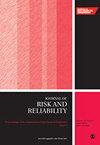Operational safety hazard identification methodology for automated driving systems fleets
IF 1.8
4区 工程技术
Q3 ENGINEERING, INDUSTRIAL
Proceedings of the Institution of Mechanical Engineers Part O-Journal of Risk and Reliability
Pub Date : 2024-02-27
DOI:10.1177/1748006x241233863
引用次数: 0
Abstract
The safety of Automated Driving Systems (ADS) operating as Mobility as a Service (MaaS) depends on multiple factors in addition to the vehicle’s functionality, reliability, and performance. Currently, no comprehensive approach has been formally developed to identify operational safety hazards and define the operational safety responsibilities of the key agents involved in Level 4 (L4) ADS MaaS operations. This work develops and applies a structured hazard identification methodology for this operation. The methodology leverages and complements the strengths of various hazard identification and modeling methods, including Event Sequence Diagram (ESD), Concurrent Task Analysis (CoTA), System-Theoretic Process Analysis (STPA), and Fault Tree Analysis (FTA). The methodology is applied to analyze the operation of a fleet of L4 ADS vehicle fleets without a safety driver, monitored and supervised by remote operators. The results highlight the fleet operator’s role in ensuring the correct vehicle operation and preventing and mitigating incidents. The analysis demonstrates the developed methodology’s strengths and suitability for operational safety analysis of complex systems’ operations, considering the inherent complexity of the interactions between multiple human and machine agents.自动驾驶系统车队运行安全危险识别方法
以 "移动即服务"(MaaS)方式运行的自动驾驶系统(ADS)的安全性取决于车辆的功能、可靠性和性能等多重因素。目前,还没有正式开发出一种全面的方法来识别运行安全隐患,并确定参与第 4 级(L4)自动驾驶系统 MaaS 运行的关键代理的运行安全责任。这项工作为这一操作开发并应用了结构化危险识别方法。该方法利用并补充了各种危险识别和建模方法的优势,包括事件序列图 (ESD)、并发任务分析 (CoTA)、系统理论过程分析 (STPA) 和故障树分析 (FTA)。该方法被用于分析一支没有安全驾驶员、由远程操作员监控的 L4 ADS 车队的运行情况。结果凸显了车队操作员在确保车辆正确运行以及预防和减轻事故方面的作用。考虑到多个人类和机器代理之间互动的固有复杂性,该分析展示了所开发方法的优势和对复杂系统运行安全分析的适用性。
本文章由计算机程序翻译,如有差异,请以英文原文为准。
求助全文
约1分钟内获得全文
求助全文
来源期刊

Proceedings of the Institution of Mechanical Engineers Part O-Journal of Risk and Reliability
ENGINEERING, MULTIDISCIPLINARY-ENGINEERING, INDUSTRIAL
CiteScore
4.50
自引率
19.00%
发文量
81
审稿时长
6-12 weeks
期刊介绍:
The Journal of Risk and Reliability is for researchers and practitioners who are involved in the field of risk analysis and reliability engineering. The remit of the Journal covers concepts, theories, principles, approaches, methods and models for the proper understanding, assessment, characterisation and management of the risk and reliability of engineering systems. The journal welcomes papers which are based on mathematical and probabilistic analysis, simulation and/or optimisation, as well as works highlighting conceptual and managerial issues. Papers that provide perspectives on current practices and methods, and how to improve these, are also welcome
 求助内容:
求助内容: 应助结果提醒方式:
应助结果提醒方式:


